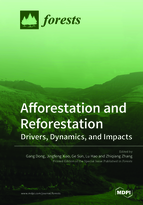Afforestation and Reforestation: Drivers, Dynamics, and Impacts
A special issue of Forests (ISSN 1999-4907). This special issue belongs to the section "Forest Ecology and Management".
Deadline for manuscript submissions: closed (25 July 2018) | Viewed by 48184
Special Issue Editors
Interests: carbon cycle; remote sensing; climate-vegetation interactions; upscaling; terrestrial biosphere modeling
Special Issues, Collections and Topics in MDPI journals
Interests: effects of climate change and land management on water quantity and quality, and water supply and demand at a regional scale; Application of computer simulation models, GIS, and remote sensing in regional hydrology; Evapotranspiration and ecosystem productivity modeling at regional to continental scales
Special Issues, Collections and Topics in MDPI journals
Interests: ecohydrology; climate change; meteorology, risk management
Interests: reforestation, water and carbon balance; climate change
Special Issue Information
Dear Colleagues,
Afforestation/Reforestation (or Forestation) has been implemented worldwide as an effective measure to sustain ecosystem services and address global environmental problems such as climate change. The conversion of grasslands, croplands, shrublands, or bare lands to forests can dramatically alter forest water, energy, and carbon cycles, and, thus, ecosystem services (e.g., carbon sequestration, soil erosion control, and water quality improvement). Large-scale afforestation/reforestation is typically driven by policies, and in turn can have substantial socioeconomic impacts as well. To be successful, forestation endeavors require novel approaches that involve a series of complex processes and interdisciplinary sciences. For example, exotic or fast growing tree species are often used to improve soil conditions of degraded lands or maximize productivity, and it often takes a long time to understand and quantify the consequences of such practices at watershed or regional scales. Maintaining the sustainability of man-made forests is increasingly challenging under a changing environment and disturbance regime change such as wildland fires, urbanization, drought, air pollution, climate change, and socioeconomic change. Therefore, this Special Issue focuses on case studies on the drivers, dynamics, and impacts of afforestation/reforestation at regional, national, or global scales. These new studies bring an update on science advances related to forestation. The information is urgently needed by land managers and policy makers to better manage forest resources under a rapidly changing environment today.
This Special Issue invites submissions based on field experiments, remote sensing, modelling, syntheses and reviews, as well as new technology used in forestation monitoring and assessment. Suggested topics are:
- Monitoring and detecting the rates and extent of afforestation/reforestation
- Quantifying impacts of afforestation/reforestation on ecosystem services (e.g., carbon sequestration, water supply, soil conservation, micrometeorology, biodiversity)
- Impacts of afforestation/reforestation on regional and global climate
- Human dimensions of afforestation and reforestation (e.g., policies, governance, and socioeconomic impacts)
- Innovative management approaches (e.g., prescribed fires, thinning) to sustain ecosystem services of man-made forests under a changing environment.
Dr. Jingfeng Xiao
Dr. Ge Sun
Dr. Lu Hao
Dr. Gang Dong
Dr. Zhiqiang Zhang
Guest Editors
Manuscript Submission Information
Manuscripts should be submitted online at www.mdpi.com by registering and logging in to this website. Once you are registered, click here to go to the submission form. Manuscripts can be submitted until the deadline. All submissions that pass pre-check are peer-reviewed. Accepted papers will be published continuously in the journal (as soon as accepted) and will be listed together on the special issue website. Research articles, review articles as well as short communications are invited. For planned papers, a title and short abstract (about 100 words) can be sent to the Editorial Office for announcement on this website.
Submitted manuscripts should not have been published previously, nor be under consideration for publication elsewhere (except conference proceedings papers). All manuscripts are thoroughly refereed through a single-blind peer-review process. A guide for authors and other relevant information for submission of manuscripts is available on the Instructions for Authors page. Forests is an international peer-reviewed open access monthly journal published by MDPI.
Please visit the Instructions for Authors page before submitting a manuscript. The Article Processing Charge (APC) for publication in this open access journal is 2600 CHF (Swiss Francs). Submitted papers should be well formatted and use good English. Authors may use MDPI's English editing service prior to publication or during author revisions.
Keywords
- Reforestation
- Afforestation
- Ecosystem services
- Ecohydrology
- Forest wildfire
- Carbon and water flux
- Forest management
- Climate change







